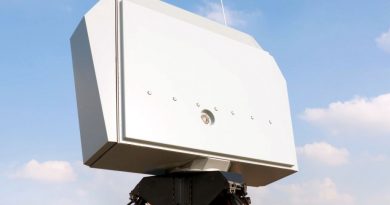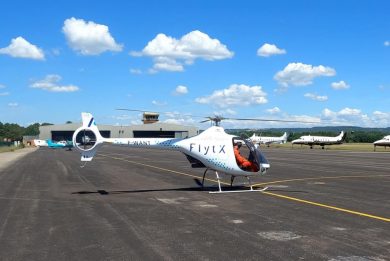
PAS 2025 – KNDS France and Thales present the land-based variant of the 40 mm RAPIDFire
The system based on the 40CT cannon, CT standing for Cased Telescoped ammunition, was exhibited in different forms in the past years. Following the first deliveries of the naval version, which is being installed on several French Navy vessels, KNDS France and Thales showcased the final land version of this weapon system at the Paris Air Show

The increasing threat from the third dimension, with drones of different kind and loitering munitions adding to the already existing dangers posed by manned platforms and missiles, have brought air defence assets among top priorities for many land forces.
In Navy use the RAPIDFire is not only meant to deal with air targets, as its high rate of fire and the lethality of the various types of rounds available make it ideal also to counter high-speed surface threats, mostly coming from unconventional systems such as jet-skis or small boats. One of the plusses of the 40CT cannon is its capacity to switch from one type of round to another instantaneously, choosing among various types, while all other medium-calibre weapons can choose among two types at the most.
The French Navy has already deployed the RAPIDFire operationally, the first of class of its new fleet replenishment tanker, the Jacques Chevallier, having completed two long-duration deployments, with France’s carrier strike group. The second ship, the Jacques Stosskopf, will soon leave for a long duration deployment, both ships being fitted with two systems, while a fifth will soon be installed on a French Navy offshore patrol vessel.

The system will however become a joint capacity, as the French Air and Space Force is going to receive soon two RAPIDFire in the land version that will undergo operational testing, the service intending using them for base and key targets protection.
Overall, the DGA, the French defence procurement agency, awarded a contract for 48 RAPIDFire systems, EDR On-Line understanding that 14 of them will go to the Navy. Another key step was the contract for the final development of the A3B (Anti-Aerial Air Burst) filed to KNDS by the DGA, which will bring the new munition in service by 2027, this ammunition being the one that will give the system an optimal capability against UAVs. Moreover, on the opening day of the Paris Air Show, the DGA assigned to KNDS a contract worth around Euro 150 million for 25,000 40 mm rounds, aimed at the Navy systems as well as at the Army Jaguar reconnaissance vehicles, these too being armed with the CTAI 40 mm cannon. A dual supply of key components has also been established to increase the ammunition joint production capacity between France and the United Kingdom.

At the Paris Air Show only the firing module of the RAPIDFire land version was visible, in a light/dark grey camouflage, which only lacked the meteorological sensors; the full land version comes in the form of a 20-foot flatbed that hosts the firing module as well as a generator providing electric power to the system and the air conditioning system, the latter being the same used on the Serval 4×4 vehicle, a cost-saving measure. KNDS had to put on board the flatbed all what is provided by the ship in the naval version, and repackage the electronics; this makes the single RAPIDFire Land system wholly independent, with only a fibre-optic cable needed to connect it to the command-and-control (C2) centre. With KNDS being the specialist in cannons, turrets and ammunition, Thales does not bring only the sighting system, but also the knowledge in Ground-Based Air Defence (GBAD). The optronic package is the only sensor installed on the firing module and provides data to the fire control system, the French concept of operation preferring a distributed solution, therefore other sensors, such as the radar, are installed on different platforms.
The flatbed solution adopted allows to employ the RAPIDFire Land in static position, to protect valuable assets, or in a mobile version, maintaining the system on board an 8×8 truck.

The open architecture allows to plug the RAPIDFire into a wide number of C2 systems, making it an additional layer in the defence against third dimension threats. “The system stands at the border between the very short-range air defence (VSHORAD) domain and the counter-UAS one, as it can deal with conventional threats while adding considerable range to the C-UAS mission,” KNDS representatives told EDR On-Line, the 40 mm cannon having an effective range up to 4,000 metres. They also underlined how much extreme accuracy has become a must: “The goal is no longer to fire as many munitions as possible to neutralise what is in the air, the aim is now to be very precise, for two main reasons. First, it allows to conduct more interceptions with one magazine, second, it allows reducing the interception cost for each single threat.” The RAPIDFire has 70 ready-to-fire rounds in the turret, but growth potential allows to double the number of ammunitions. Calculating the muzzle velocity for each round is key to obtain utmost accuracy, hence getting maximum lethality with the minimum number of rounds, especially when using A3B rounds which fuse is programmed based on the V0 and future intercept point. Engagement cost is definitely an issue, and a system such as the RAPIDFire is the optimal complement to missile-based systems, which inherently have a much lesser firing autonomy, and should be reserved to high value/high priority targets.
No details were yet provided on the A3B munition, which as already mentioned is in the final development stage, being currently considered at TRL5. “This ammunition will cause a hailstorm in front of the target. We have some small secrets concerning the tungsten pellets, dimensions, geometric shape, and so on, and we are not yet ready to reveal these as there is still very significant competition in this sector of activity,” EDR On-Line was told, understanding that not much will be added, at least until the new ammunition will be fully qualified.
KNDS explained that algorithms developed for the current configuration, which allow among other to optimise the engagement sequence in terms of number of rounds according to the type of target, are “trained” using artificial intelligence-based scenarios, the company defining them as “expert systems”; AI is therefore used during their development, while no AI algorithm per se is currently part of the system. This does not mean that KNDS is not considering AI insertion, one of the aims being to have a single operator capable to manage multiple systems in complex scenarios, the company considering such evolutions to be developed in close cooperation with customers. Currently the time to get the green light for firing is around 30 seconds, something not compatible with massive swarm attacks from drones flying at over 200 m/s with no IR signature and very low radar cross section, therefore soon or late a solution to reduce this gap must be found, even if the man-in-the-loop remains a must for the time being.
EDR On-Line understood that of the 48 RAPIDFire on order 14 are aimed to the Navy, which already received five of them, two more being those under delivery to the Air Force in the land version, the remaining to be acquired in batches, the Army being probably the last to get them, as it will first receive the VAB-based ARLAD C-UAS system, probably followed by the Serval LAD, a system based on the 4×4 armoured vehicle armed with an ARX-30 turret, both the platform and turret being provided by KNDS France. According to planning the Army should get a C-UAS system based on the RAPIDFire in 2032.
Images and photos courtesy KNDS France and P. Valpolini



